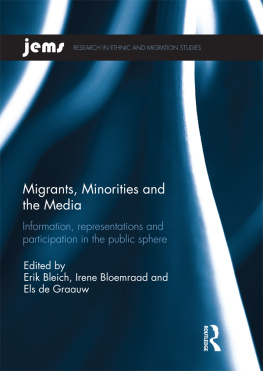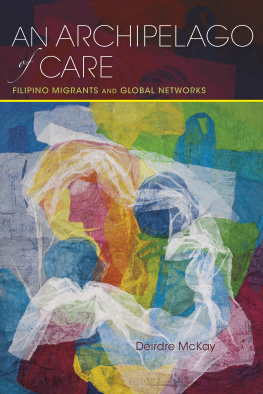Linking Separate Worlds
Explorations in Anthropology
A University College London Series
Series Editors: Barbara Bender, John Gledhill and Bruce Kapferer
Linking Separate Worlds
Urban Migrants and Rural Lives in Peru
Karsten Paerregaard
First published 1997 by Berg Publishers
Published 2020 by Routledge
2 Park Square, Milton Park, Abingdon, Oxon OX14 4RN
605 Third Avenue, New York, NY 10017
Routledge is an imprint of the Taylor & Francis Group, an informa business
Karsten Paerregaard 1997
All rights reserved. No part of this book may be reprinted or reproduced or utilised in any form or by any electronic, mechanical, or other means, now known or hereafter invented, including photocopying and recording, or in any information storage or retrieval system, without permission in writing from the publishers.
Notice:
Product or corporate names may be trademarks or registered trademarks, and are used only for identification and explanation without intent to infringe.
Library of Congress Cataloging-in-Publication Data
A catalogue record for this book is available from the Library of Congress.
British Library Cataloguing-in-Publication Data
A catalogue record for this book is available from the British Library.
ISBN 13: 978-1-8597-3103-1 (hbk)
Typeset by JS Typesetting, Wellingborough, Northants.
for Ana Mara, Laura and Sofie
Like Andean migrants' fabulous search for a new life, this book is the outcome of a long and exciting travel through Peru's many worlds. Its first incarnation was a Ph.D. thesis for the University of Copenhagen about the people living in the district of Tapay, a remote village in the southern Andes. When I left Lima in January 1986 to take up field research in Tapay I had no idea that the outcome of my work was going to be a book on the links that tie Spanish-speaking urban migrants in Peru's cities to their native village.
In many ways, the linking of separate worlds to which the title of this book alludes is a collective endeavour by numerous people. These, of course, include the migrants themselves, whose daily lives is the result of a struggle to combine two apparently incompatible worlds, the city and the village. But other people also take part of this endeavour: the migrants' relatives and fellow villagers in Tapay, their spouses, who often originate from other parts of the Peruvian Andes, and their children born in the city. Indeed, by allowing me to study them, I became part of their endeavour. The tittle of the book therefore reflects the daily struggle of urban migrants as well as the analytical efforts of the researcher to create and conceptualize the links which connect Peru's many worlds.
Needless to say, this book would never have been written without the help of the migrants and villagers of Tapay, to whom I would like to express my gratitude, in particular, those who offered me shelter and food and took an interest in my study. Many others have also played important roles. Ana, Flora, Csar and Flor, four students of San Agustn University, assisted during my 1986 stay in Tapay and during my 1990 study in the city of Arequipa. Likewise, Regina from the Catholic University of Peru assisted me in Lima. In Peru, I am also indebted to Tefilo Altamirano and Juan Ansin from the Catholic University in Lima for their support arid friendship over many years. My thanks also go to Maria Benavides, with whom I have had many inspiring discussions about the Colca people. A personal friend during my many years in Peru, Salvador Palomino has instructed me in Quechua. In the US, Paul Gelles and Blenda Feminias always offered me support and inspiration. It was David Guillet who initially suggested I go to Tapay. William Mitchell has also been of much help. I would also like to thank Tom Zuidema and his wife for taking interest in my research.
The bulk of this book was written during a stay as Visiting Professor at the Center for Latin American Studies, University of Florida. My thanks go to Allan and Julie Burns for their personal support and warm hospitality. I am also indebted to Paul and Polly Doughty and to Vicky and Philip Williams, who transformed our stay in Gainesville to a marvellous year. Finally, I thank the people at the Center for Latin American Studies and the Department of Anthropology for their support.
In Denmark, my thanks go the Department of Anthropology at the University of Copenhagen, where I have found much theoretical inspiration over the years. In particular I would like to express my gratitude to Niels Fock, who was my Ph.D. supervisor. Funding for my field research in Peru was provided by Danida (the Danish International Development Agency), the Danish Social Science Research Council, the Danish Research Council for the Humanities, the Carlsberg Foundation and the University of Copenhagen.
Finally, I would like to thank my wife, Ana Maria Torres, together with Laura and Sofie, our two daughters, for all their help and inspiration while writing this book. I am also indebted to my parents as well as to my parents-in-law for their support.
originally appeared in Ethnos 1994/3-4. pp. 168-86; it is reprinted here with the permission of the Scandinavian University Press.
Karsten Paerregaard
1
Looking beyond the Andes
It was one of those beautiful Sunday mornings in Lima which gives you a sense of what the city must have looked like when it was still called the garden city. The sun was shining and the people had only just begun to appear on the streets. The usually busy and overcrowded city was quiet and the smog, which normally hangs over Lima from May to November, had given way to a blue sky. I was on my way to a neighbourhood on the northern outskirts of the city, where migrants from a village in the southern highlands of Peru were supposed to be meeting for a game of soccer. Upon leaving the apartment which my family and I had rented in San Isidro, one of Lima's upper-class suburbs, I turned on the radio in my Volkswagen. A local station was playing salsa, music particularly popular with Peru's criollo population, the Spanish-speaking mestizos who live in the coastal cities. After a twenty-minute drive, the music began to fade and suddenly a new station took over the frequency. Salsa had given way to huayno, the most popular form of music among Andean peasants and urban migrants. By this time I knew that I had left the 'official' reaches of Lima and entered the 'unofficial' Lima, i.e. the ring of shanty towns surrounding the Peruvian capital. I was in Comas, one of Lima's largest pueblos jvenes (young towns).
My drive to Comas required me to cross one of Peru's many cultural frontiers. The sudden shift between competing radio stations and different music styles reflects the division of Peruvian society into two opposed but nevertheless cohabiting worlds: the Andean, Peru's traditional, rural, Indian, informal, vanquished culture, and the criollo, Peru's modern, urban, Western, official, conquering culture. This schism in fact dates back more than 450 years, to the time of the conquest. After the Spaniards defeated the Inca empire in 1532, they destroyed the capital, Cusco, which was located in the southeastern highland and established a new city in its place, Lima, which became the administrative centre of the viceroyalty of Peru and later Peru's capital. The city was situated at the point where the Rmac River crosses the coastal desert.






